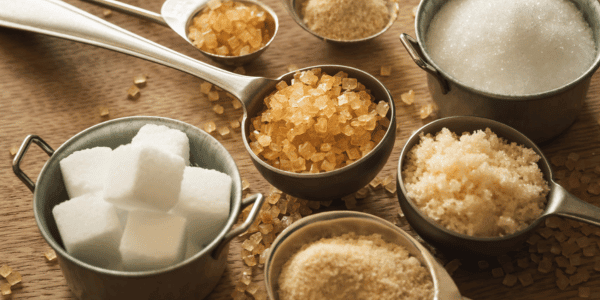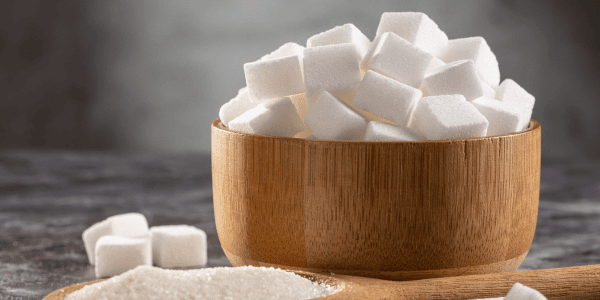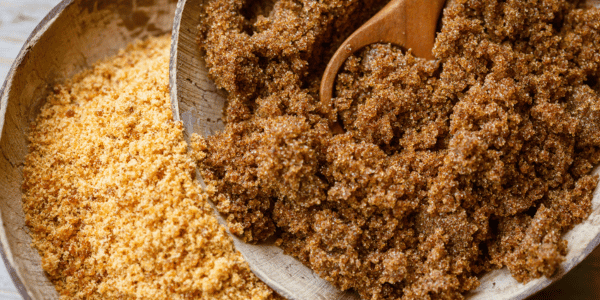12 Different Types of Sugar & How to Use Them

Spoonfuls of sugar create some of the most delicious dishes, and the sugar variety you use has a major impact on the flavor, texture, and more. Whether you’re using sugar for baking, cooking, decorating, or even making drinks, knowing your different sugars can be the key to taking recipes to the next level. Here are 12 types of sugar and details on how to put these common sugars to good use in your kitchen.
What is Sugar?
Sugar, scientifically known as sucrose, is a simple carbohydrate naturally produced in plants, fruits, vegetables, and nuts. The sugar that we have in our pantries comes from those sources, mainly sugar beet and sugar cane plants. While the details of sugar’s makeup are complex, its purpose is simple; like all other carbs, sugar gives you energy, while its extract provides a splash of sweetness to everything it touches.
How is Sugar Made?
Chemically, sugar is produced through the process of photosynthesis in green plants, specifically sugar cane. When those plants are harvested, their stalks are washed and cut up and rollers are used to extract their juices. Then the juice is concentrated and crystalized. Afterwards, it’s spun in a centrifuge to remove the liquid molasses and the sugar is melted and filtered. Once the molasses is completely separated, the remaining sugar crystals are crystalized and dried to look like what is sold in stores.
What Are the Different Types of Sugar?
The sugar you choose for a recipe that calls for something sweet is important. Don’t just take whatever you already have on hand and toss it in. Consider the type of sugar you’re using and how it can completely change the food or drink you’re making based on its own unique qualities. Here are 12 different sugars and what they’re used for.
1. Granulated Sugar
Granulated sugar, also known as white sugar or table sugar, is a common sugar variety found on store shelves and used in baking. It’s made by whitening and grinding down sugar extracted from sugar beet or sugar cane plants. A go-to, pure sucrose sugar with neutral sweetness, its size and texture are similar to table salt.
What is granulated sugar used for? Cakes, cookies, pies, bread
2. Powdered Sugar
Also known as confectioners’ sugar, powdered sugar is granulated sugar ground down and mixed with cornstarch. It dissolves rapidly, making it ideal for dishes where sweetness is needed but the texture or appearance of sugar isn’t required or wanted.
What is powdered sugar used for? Frosting, icing, doughnuts, marshmallows

3. Sugar Cubes
Sugar cubes are white sugar pressed into cube shapes, a concept invented in the 1800s. At that time, sugar was sold in loaves or lumps that consumers had to cut themselves. The cube form was invented to make sugar easier to measure and store, and today, they’re popular as a quick way to sweeten beverages like tea.
What are sugar cubes used for? Sweetening drinks
4. Cane Sugar
Cane sugar is minimally processed white sugar. It’s made by simply taking the extracted juices of sugar cane stalks in unrefined, refined, or raw forms. With larger crystals and a light golden color, it can be added to recipes in place of granulated sugar or used as a garnish.
What is cane sugar used for? Cakes, cupcakes, muffins, cookies
Almost every recipe for baked sweets needs sugar and flour. Learn more about “The Power of Flour” today!
5. Sanding Sugar
A large, coarse-grained sugar with a shiny, polished appearance, sanding sugar works best for decorating treats and rimming cocktail glasses. It’s heat resistant, comes in countless colors, and gives every treat a sparkly and noticeable crunch.
What is sanding sugar used for? Sugar cookies, gingerbread houses, cakes
6. Caster Sugar
Sometimes called superfine sugar, caster sugar is a finer version of white sugar, lying somewhere in between the granulated and powdered versions. This gives the sugar a unique dissolving point, making it a top sweetener for cold drinks.
What is caster sugar used for? Whipped cream, meringue, sweetening cold drinks
7. Brown Sugar
Brown sugar gets its color and flavor from molasses mixed with white sugar. Compared to white sugar varieties, molasses delivers a darker, more caramel-like sweetness. Because molasses absorbs water, brown sugar mixes well with sips and sauces.
What is brown sugar used for? Bacon seasoning, sauces, marinades
8. Muscovado Sugar
A less-refined version of brown sugar, muscovado sugar has a richer color and sticky texture due to its higher molasses content. With a stronger flavor than standard brown sugar, muscovado sugar is perfect for intensifying the taste of your favorite sweet treats.
What is muscovado sugar used for? Brownies, gingerbread, oatmeal, ice cream
9. Demerara Sugar
Made from evaporated sugar cane juices, demerara sugar doesn’t undergo a full processing method. With a toffee or caramel-like flavor, it’s amber in color and has larger grains that are great for topping foods that need a little extra texture.
What is demerara sugar used for? Sugar cookies and crème brûlée
Sugar and tea go hand-in-hand. Check out our “There’s a Tea for That” guide to learn about the drink’s healing effects.
10. Coconut Sugar
Though technically not brown sugar, coconut sugar shares a similar appearance. Made from the sap of coconut palm trees, this type of sugar has a hint of tropical fruit flavor, though it typically has the caramel-like taste found in brown sugar.
What is coconut sugar used for? Cookies, pancakes, waffles
11. Liquid Sugar
By dissolving white granulated sugar into water, a liquid form of sugar can be used to fill pastries and candies and sweeten plenty of other delicacies.
What is liquid sugar used for? Drinks, jams, preserves

12. Artificial Sweeteners
If you’re looking to cut sugar out of your diet, artificial sweeteners are chemically made substances that provide the flavor of sugar without the calories and health impact.
What are artificial sweeteners used for? Soft drinks, tea, coffee, gum, candy
Beyond Different Sugars: Cooking Tips Continued
Now that you’re well aware of the 12 different types of sugar and common sugars, did you know that salt comes in different varieties, too? From table salt to flavored salt and so many others, we show you how specific salts can be used to make meals tastier than ever before in our article, “A Guide to Cooking with Salt: How to Use 13 Varieties.”
Sugar FAQs
Which type of sugar is the healthiest?
Natural sugars found in fruits, vegetables, nuts, and grains are the healthiest, though all sugars can be harmful if they’re overconsumed.
Are natural sugars better than artificial sweeteners?
Most health experts believe that natural sugars are better for you than added sugars or artificial sweeteners because they don’t require chemical processing and are found in healthier food options.
What is the best sugar for baking?
Granulated sugar is the most popular option used for baking since it has a neutral flavor and crystals that are small enough to dissolve completely when cooked.
Can I substitute white sugar for brown sugar?
Most baking recipes will still work if you substitute white sugar for brown sugar. If that’s necessary, use a one-to-one ratio.
How to soften brown sugar?
Brown sugar can be softened in the microwave. Cover the sugar with a damp towel and microwave in 20-second intervals until you reach the desired softness.
